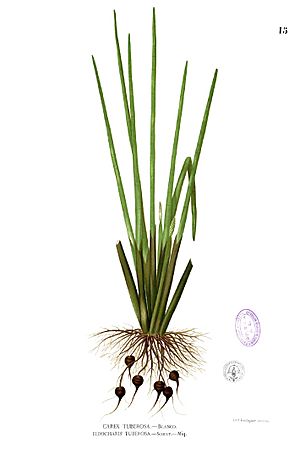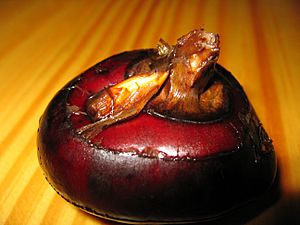Chinese water chestnut facts for kids
Quick facts for kids Water chestnut |
|
|---|---|
 |
|
| Scientific classification | |
| Kingdom: | |
| (unranked): | |
| (unranked): | |
| (unranked): | |
| Order: | |
| Family: | |
| Genus: | |
| Species: |
E. dulcis
|
| Binomial name | |
| Eleocharis dulcis |
|
The Chinese water chestnut or water chestnut (scientific name: Eleocharis dulcis) is a special plant that looks a bit like grass. It's actually a type of sedge, which is a plant similar to grass. You can find it growing naturally in many parts of Asia, like China, Japan, and India. It also grows in Australia, tropical Africa, and on islands in the Pacific and Indian Oceans. People grow this plant in many countries because of its yummy, edible corms.
A water chestnut is not a nut at all! It's an aquatic vegetable. This means it grows in water, usually in marshes or muddy areas. Its leaves are like hollow green tubes and can grow up to 1.5 meters tall. Sometimes, people confuse it with the water caltrop, which is a different plant entirely.
The small, round corms of the water chestnut have a crisp, white inside. You can eat them in many ways: raw, lightly boiled, or grilled. They are also often pickled or canned. Water chestnuts are a very popular ingredient in Chinese cooking. In China, they are often eaten raw, sometimes with a little sweetness added. They can also be ground into flour to make water chestnut cake. This cake is a common part of dim sum meals.
Water chestnuts are special because they stay crunchy even after being cooked or canned. This is because their cell walls are extra strong. Other vegetables like the tiger nut and lotus root share this cool property. The corms also contain a natural substance called puchiin, which can act like an antibiotic and stays strong even when heated. Besides the edible corms, the leaves of the plant can be used to feed cattle, or as mulch or compost for gardens.
Water chestnut corms are full of good things for you! They have a lot of carbohydrates, especially starch. They are also a good source of dietary fiber, riboflavin, vitamin B6, potassium, copper, and manganese. It's important to cook water chestnuts properly before eating them to avoid any potential health issues that can come from eating them raw.
Contents
What Water Chestnuts Taste Like
When raw, water chestnuts are a bit sweet and very crunchy. If you boil them, they become firm and still slightly crunchy. Boiled water chestnuts have a very mild, slightly nutty flavor. This means their taste can easily be covered up by other flavors from sauces or seasonings.
Water chestnuts are often mixed with other ingredients like bamboo shoots, coriander, ginger, sesame oil, and snow peas. You'll often find them in steamed or sautéed vegetable mixes. They are also a common addition to noodle or rice dishes.
Where Water Chestnuts Get Their Name
The Chinese water chestnut is native to China. Its name in traditional Chinese is 荸薺 and in simplified Chinese it's 荸荠. It's also called 馬蹄 in Chinese, which means "horse's hoof" because of its shape.
It's grown widely in wet paddy fields in southern China. In parts of the Philippines, it's called apulid. In Vietnam, it has different names depending on the region: củ mã thầy in the north and củ năng in the south. It's a key ingredient in Vietnamese desserts like bánh củ năng hấp and chè mã thầy. In Thailand, it's known as haeo (แห้ว) and is often used in a popular dessert called thapthim krop (ทับทิมกรอบ). In India, people commonly call it singhada, shingada, or singoda.
How Water Chestnuts Are Grown
Growing the Plants
Water chestnuts can be grown in special wet fields called paddies. These fields can be up to 100 meters long. They can also be grown using a method called hydroponic culture, where plants grow in water without soil. Since it's an aquatic plant, it always needs to be covered by about 10 centimeters of water.
The plant needs warm soil temperatures, ideally around 14-15.5 degrees Celsius. The corms, which are the edible parts, start to sprout when the temperature reaches about 13.6 degrees Celsius. The best soil for water chestnuts is sandy loam, with a pH between 6.5 and 7.2.
The water chestnut plant grows two types of underground stems called rhizomes. If the days are long, the rhizomes grow sideways and then turn upwards to form new baby plants. If the days are short, the rhizomes grow downwards and form a corm at their tip. The amount of daylight (called photoperiod) also affects how fast the corms grow. They grow much slower if the daylight lasts longer than 12 hours. The corms themselves can be used to grow new plants. Farmers can also use special machines to plant them.
Feeding the Plants
Adding nitrogen helps the corms grow bigger. Farmers usually add some nitrogen before planting and again when the corms start to get larger. To make the plants even healthier, farmers can use potassium and phosphorus fertilizers before planting. Organic mulch, especially mushroom compost, also works very well to help the plants grow.
Harvesting the Corms
Water chestnuts are ready to be harvested when their corms turn a dark brown color. If they are left in the soil for too long after this, they will become sweeter, but they won't last as long after being picked.
Farmers can harvest the corms using special machines after the paddy field is drained. Another type of machine, called a "water-suction harvester," can pick the corms without needing to drain the field. After harvesting, the corms need to be washed and brushed clean once they are dry.
See also
 In Spanish: Castaña de agua para niños
In Spanish: Castaña de agua para niños


